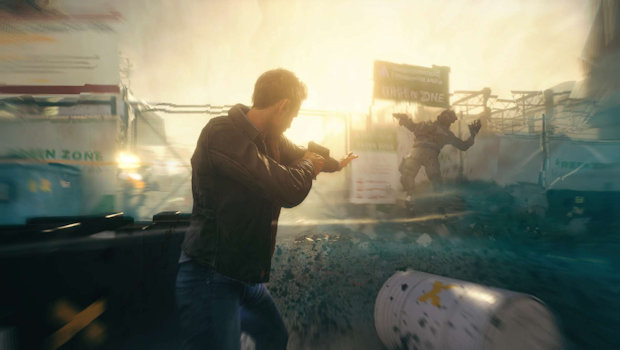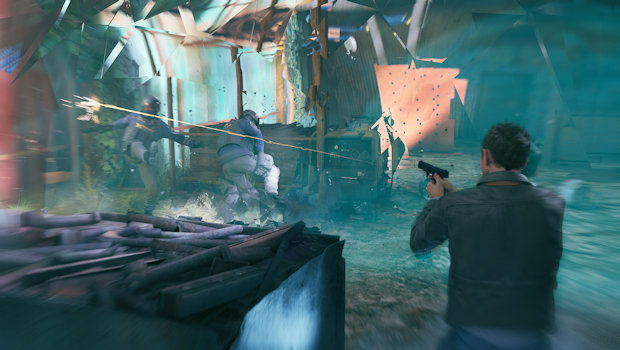Over the last 20 years, Remedy Entertainment has made a name for itself making games that experiment with genre storytelling and different gameplay mechanics under the guise of what seems to be a typical 3rd person shooter. It is a formula that has worked well for them on past hits such as Max Payne and Alan Wake. And Quantum Break, their latest title, continues this trend with a combination of science fiction storytelling stacked with time-bending gameplay mechanics that appear in a game that looks, and initially feels, like a typical cover based shooter.
As the game’s onset, I took control of Jack Joyce (played by Shaun Ashmore). Joyce was heading to the lab of his estranged friend Paul Serene (Aiden Gillen) after getting a request to join him there for something monumental but secret. Serene quickly detailed his intentions to use the time travel machine Jack’s brother, William Joyce (Dominic Monaghan), has created. Jack, for whatever reason, went through with his plan and things go to hell pretty quickly. The result: Paul getting trapped and the machine caused a fracture in time and sets about starting the end of time all together. This turn of events bestowed upon Jack some pretty snazzy time powers and his old buddy Paul became an evil Steve Jobs with time powers of his own. It’s undoubtedly something of a cheesy set-up. But I’ve seen worse in all manner of media and there is just something charming about Remedy’s approach here. Like with both Max Payne and Alan Wake, Remedy has fully embraced the genre its story is in. There is a love for B-level sci-fi here that makes everything that happens a ton of fun.
Quantum Break followed a very specific structure. For about 80% of the game I played as Jack. Most of that time I spent fighting enemies in sandbox encounters that are set up a lot like your typical third person shooter might be. But while they appear typical, playing the encounters as such will more often than not result in you ending up dead a lot. Jack has time powers and using them in combat is the key to survival, and also provided some of the coolest moments I’ve had in a game this gen. At first Jack can only freeze time in a particular area but over the course of the game he gets more and more powers that allow for interesting usage combinations. Freeze an enemy and stack a clip of shots into the time bubble so when it dissolves he gets hit with everything at once, then time rush over to melee take down another guy, time blast a third guy, and throw up a shield to protect against the light machine gunner heading your way.
I never felt there was a particular way to take on an encounter and the powers at my disposal always gave me a means to even the odds. Well, all except when I ran across some time power suppressing areas that made me play the game as a traditional third person shooter. Those encounters are the worst the game has to offer and that is because as a base shooter, Quantum Break is only passable. Thankfully the areas that suppress your time powers only encompass a few of the many combat encounters and they don’t detract from the creative and fun dynamic gameplay the rest of the game offers.
Aside from combat, playing as Jack saw me doing some simple puzzle solving and platforming. Neither the puzzle solving or the platforming is groundbreaking but it does serve as a nice way to cool down from the high intensity combat scenarios. And at least one of the “puzzles” required me doing multiple steps to get what I needed to advance. There were also tons of collectibles to be found in each level. From narrative focused pieces that enhance the world to upgrade points, I never found myself with nothing to do in an area and I enjoyed scouring each level for everything I could find.
After finishing an act as Jack, the perspective switches to the perspective of Paul. These sections are small, taking up about 5% of the total game time, but they are designed to offer divergent paths for how the game plays out. Paul is tasked with making a decision that will have consequences, both good and bad, for him and Jack. It’s interesting but the way the game plays as Jack, I don’t see how different things could be regardless of choice. Maybe a secondary character is no longer around but it all seems to get to the same point eventually regardless of these decisions. That said, being able to choose the villain’s motivations allowed me to see a bit more into his head and made me feel the game was more mine, even if the end point was always going to be the same.
The elephant in the room of course is the other 20% of the game. That portion of Quantum Break comes in the form of four 30 minute television episodes that bookend the first four acts of the game (there are five acts in total). But these aren’t just 30 minute cutscenes of our primary characters expanding the story; in fact, they only minimally feature the main characters. These episodes focus on a cast of tertiary characters whose actions don’t always directly impact Jack or Paul’s events on the gameplay side. They do however help to explain some aspects of the final act, which without the episodes one might be scratching their head at some of the leaps that have to be made. And any time we get to see more Lance Reddick on screen is OK with me.
I enjoyed my time with Quantum Break and the structure lends itself well to segmenting my play sessions with it. I can see this might cause a feeling of it being a bit disjointed. Remedy’s choice to take you out of the primary protagonist for 30-40 minutes at a time and for 30 of that to be completely non-interactive was a bold choice that isn’t going to be for everyone. But it is that willingness to experiment that I think makes Quantum Break something special and worth playing.


